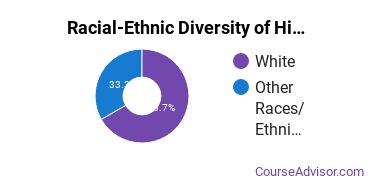History at University of Idaho
U of I is located in Moscow, Idaho and has a total student population of 10,791.
Want to know more about the career opportunities in this field? Check out the Careers in History section at the bottom of this page.
U of I History Degrees Available
- Bachelor’s Degree in History
- Master’s Degree in History
Online Classes Are Available at U of I
Don't have the time or the flexibility in your schedule to take traditional classes? Online courses may be the perfect solution for you. They allow independent learners to study when and where they want to while offering the rigor of in-person classes.
U of I does offer online education options in history for the following degree levels for those interested in distance learning:
- Bachelor’s Degree
U of I History Rankings
The history major at U of I is not ranked on College Factual’s Best Colleges and Universities for History. This could be for a number of reasons, such as not having enough data on the major or school to make an accurate assessment of its quality.
There were 0 student who received their doctoral degrees in history. This is the #140 most popular school in the United States for this category of students.
History Student Demographics at U of I
Take a look at the following statistics related to the make-up of the history majors at University of Idaho.
U of I History Bachelor’s Program

About 81% of those who receive a bachelor's degree in history at U of I are white. This is above average for this degree on the nationwide level.
The following table and chart show the race/ethnicity for students who recently graduated from University of Idaho with a bachelor's in history.

| Race/Ethnicity | Number of Students |
|---|---|
| Asian | 0 |
| Black or African American | 0 |
| Hispanic or Latino | 2 |
| White | 17 |
| International Students | 0 |
| Other Races/Ethnicities | 2 |
U of I History Master’s Program

Of the students who received a history master's degree from U of I, 100% were white. This is above average for this degree on the natiowide level.
The following table and chart show the race/ethnicity for students who recently graduated from University of Idaho with a master's in history.

| Race/Ethnicity | Number of Students |
|---|---|
| Asian | 0 |
| Black or African American | 0 |
| Hispanic or Latino | 0 |
| White | 2 |
| International Students | 0 |
| Other Races/Ethnicities | 0 |
Concentrations Within History
The following history concentations are available at University of Idaho. The completion numbers here include all graduates who receive any type of degree in this field from University of Idaho. Some of these focus areas may not be available for your degree level.
| Concentration | Annual Degrees Awarded |
|---|---|
| History | 21 |
Related Majors
- Area, Ethnic, Culture, & Gender Studies
- Philosophy & Religious Studies
- Foreign Languages & Linguistics
- Family, Consumer & Human Sciences
- Liberal Arts / Sciences & Humanities
Careers That History Grads May Go Into
A degree in history can lead to the following careers. Since job numbers and average salaries can vary by geographic location, we have only included the numbers for ID, the home state for University of Idaho.
| Occupation | Jobs in ID | Average Salary in ID |
|---|---|---|
| High School Teachers | 5,210 | $51,170 |
| Managers | 1,350 | $85,070 |
| Curators | 110 | $34,580 |
| History Professors | 50 | $94,150 |
References
*The racial-ethnic minorities count is calculated by taking the total number of students and subtracting white students, international students, and students whose race/ethnicity was unknown. This number is then divided by the total number of students at the school to obtain the racial-ethnic minorities percentage.
- College Factual
- National Center for Education Statistics
- O*NET Online
- Image Credit: By Davidlharlan under License
More about our data sources and methodologies.
